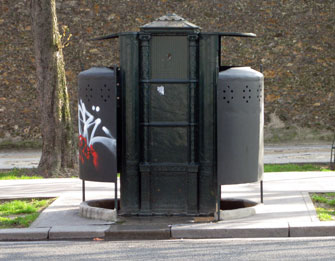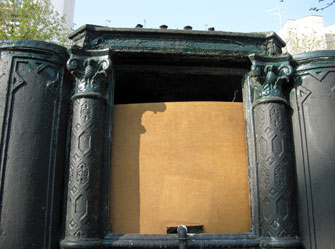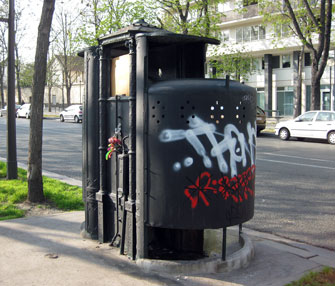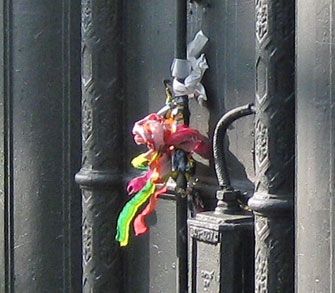
Anyone who has spent any amount of time walking and breathing in Paris may find this hard to believe, but it has been illegal here to urinate in the street since the 17th century. This has to be one of the least-enforced statutes in the history of humankind, and I personally suspect that Louis XIV moved to Versailles at least in part to get away from a capital that was essentially France’s largest men’s room.
The first semblance of public toilet facilities in the city came a full century later, in the 1770s, when the prefect of the Seine (the equivalent of the mayor back then) got the inspired idea of placing “barrels of easement” on “all the street corners of Paris.”
I’m sure this was an improvement over just allowing the effluence to fester where it fell, but it’s a pretty crude solution even for the pre-plumbing period. Barrels? Just sitting there on the street corner? They must have been awkward, not to mention humiliating, to use, arduous and unpleasant to empty, and probably just as odiferous as any secretion-soaked pavement.
Then in 1841, a new kind of fixture took its place in the Parisian cityscape: metal structures sheltering public urinals. They were called pissoirs or pissotières, for obvious reasons, and vespasiennes for a less obvious reason: at first people were calling them “Rambuteau columns” after the Count of Rambuteau, the prefect who had introduced them, and to save his family name from lexicological ignominy he suggested naming them after Vespasian, the ancient emperor who installed the first public latrines in Rome. It was a pretty good idea – the term had historical roots, a nice ring to it and an eponym who wasn’t going to sue for defamation.
At first, Parisian men thought it was absurd to relieve oneself in an edifice designed for that purpose, given that virtually every street in town was an ill-lit morass of mud and manure offering plenty of places where a gentleman might find solace. But the comfort stations slowly caught on, the design was refined, and by the end of the century there were hundreds of them all over town: green steel columns surrounded by a screen that provided just barely enough visual protection and connected to plumbing that provided just barely enough water and drainage.
Of course, they could only be used by men, and they still reeked. In essence, what the pissoirs accomplished was to concentrate one aspect of the city’s noxious filth and miasma into a relatively few specific locations.
Disgusting as they were, for many years the vespasiennes were a veritable symbol of Paris. The 1967 James Bond spoof Casino Royale even set a scene in one (excerpted about 20 seconds into the trailer):
By 1930, Paris counted about 1,200 pissoirs, and supposedly they played an important role in the Resistance movement during World War II, serving as meeting points and message drops. It makes sense – the putrid public urinals might not be the last place the Nazis would expect to find seditious activity, but they would definitely be the last place they’d want to look for it.
After the war, the city began to phase them out. By 1966, there were only 329 left, plus a handful of “chalets” for women, although the latter had always been few and far between. Urinary discrimination didn’t end until the introduction of the present-day Sanisette toilets in the 1980s, which, interestingly, were developed by the same company that runs the Vélib bike rental system, JCDecaux (corporate motto: “From piddles to pedals”).
When I first came to Paris as a tourist in the 1970s, there were still a few pissoirs here and there. I remember a small one on the Quai aux Fleurs behind Notre Dame and another one near the entrance to the Mirabeau Métro station, but by the time I moved here in the ’80s, most of them were gone.
Today there’s only one left, a double drainer on Boulevard Arago, not far from Denfert Rochereau. Henry Miller talks about one in the Luxembourg Gardens, but all I could find there was a regular 20th-century concrete urinal. Malodorous, yes. Indecent, yes – but a true vespasienne, no.
To take an authentic, original, historical Parisian pee, you have to go to Arago. Which, purely out of intercultural interest, I did once about 10 years ago. But since C’est Ironique readers deserve nothing but the freshest, latest, most reliable first-hand information, I decided last week to give it another shot. I mean look.
I can confirm that the wee cabin is still standing, although it has seen better days. One of the side screens is smeared with graffiti and one of the panels has been replaced with raw plywood:

I can also confirm that it’s still being used. And used and used and used. Including by some people who have only a sketchy notion of the definition of “urinal,” if you see what I mean. The drain on one side is completely clogged, and there’s a constant overflow of fetid water dribbling out into the gutter. It’s a good thing the sidewalk slants toward the street.
I found the old privy pretty much as I remembered, except for one odd thing. Look at this view from the sidewalk side:

What’s that little bunch of colored strands in the middle? Here’s a closer look:

Someone has – or more likely a number of different people have – left lengths of colored plastic, probably torn from shopping bags, knotted around the pipe. Why? It’s not the remnants of coded messages about German troop movements.
Maybe it’s a new fad in emulation of the “love locks” that couples put on bridges: every time someone manages to empty his bladder here without also emptying his stomach (the stench is pestilential) he puts a piece of plastic on the pissoir to commemorate the feat. I started trying to think of a name for them. Leak leashes? Whiz hitches? Tinkle links?
Then it occurred to me: the urinal is just outside Paris’s largest penal institution, La Santé Prison. Maybe the garlands are the Parisian equivalent of the well-known “yellow ribbon,” a shout-out to an inmate who’s about to be released. It has the makings of a hit song for Antony Orlandeau et l’Aube: “Tie a hunk of plastic ’round the old pi-ssoir…”
Reader Panama Red writes: “I suspect that the pissoir ribbons are the result of gentlemen not wanting to take their purchases into the pissoir and so looping the bag with contents through one of its handles to keep them out of harm’s way outside while attending to business inside. Then, mission accomplished and desperate to get away, it becomes expedient to tug on the plastic bags until the attached handle gives way, permitting escape but leaving the tell-tale flag behind.”
Reader Ronald Hurwitz writes: “Back in 1993 I made pictures of the last three remaining such edifices in Paris. I was hoping to do more but, alas, those were the only ones I could find (Arago, Mirabeau, and in front of Église Ste. Clotilde in the rue St. Dominique).
“I did discover and purchase a beautiful small volume of photos by Marville who photographed many of those structures during the 19th century. To me, they were like folies à fer, if that is proper French: small architectural iron works of intricate and artistic design, albeit questionable odiferous presence. Marville’s pictures were really beautiful and inspired me to search the city for remaining examples. Sadly, as you point out, only one remains, and barely at that.
“I was a bit surprised to see that you have omitted the main reason given for the removal: that homosexual men were in the habit of conducting late-night rendez-vous en plein air, so to speak in those locations. Proust, I believe, makes some mention of those activities in A la recherche du temps perdu.”
© 2012 Paris Update
FavoriteAn album of David Jaggard’s comic compositions is now available for streaming on Spotify and Apple Music, for purchase (whole or track by track) on iTunes and Amazon, and on every other music downloading service in the known universe, under the title “Totally Unrelated.”
Note to readers: David Jaggard’s e-book Quorum of One: Satire 1998-2011 is available from Amazon as well as iTunes, iBookstore, Nook, Reader Store, Kobo, Copia and many other distributors.

Bring them back.